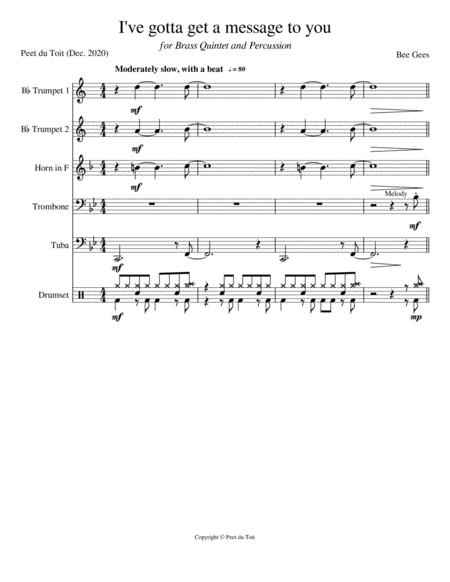Brass Ensemble Horn,Trombone,Trumpet,Tuba - Level 2 - Digital Download SKU: A0.802647 By Bee Gees. By Barry Gibb, Maurice Gibb, and Robin Gibb. Arranged by Peet du Toit. Dance,Disco. Score and parts. 23 pages. Peet du Toit #6197563. Published by Peet du Toit (A0.802647). I've Gotta Get a Message to You is a song by the Bee Gees. Released as a single on 7 September 1968, it was their second number-one single on the UK Singles Chart and their first US Top 10 hit.The song is about a man who, awaiting his execution in the electric chair, begs the prison chaplain to pass a final message on to his wife. Robin Gibb, who wrote the lyrics, said that the man's crime was the murder of his wife's lover, though the lyrics do not explicitly allude to the identity of the victim. Robin said, This is about a prisoner on Death Row who only has a few hours to live. He wants the prison chaplain to pass on a final message to his wife. There's a certain urgency about it. Myself and Barry wrote it. It's a bit like writing a script. Sometimes you can sit there for three hours with your guitar and nothing will happen. Then in the last ten minutes something will spark. The song was written with Percy Sledge in mind to record it. Sledge did record it in February 1970 but Atlantic did not issue his version in the United States at the time.Barry recalled, In those days, the lyrics were almost pretty well done on the spot. I don't remember the fundamentals on how the lyrics were formed, except that we were writing about a guy on death row. That was it.Robin adds:It was like acting, you see, we said, let's pretend that somebody, his life is on the line, somebody's going to the chair. What would be going through their mind? Let's not make it doom and gloom but sort of an appeal to the person he loves. Because right now that's all he cares about. Regardless of whether he's done a bad thing, he is a human being, and he's sending out this last message. There's someone out there whom he loves. It's a torch song, but within a very sort of theatrical sense. Not sort of abstract, but definitely somebody in a very bad situation whose life is going to end. What would they be saying, you know? This is it: 'Gotta get a message to you, hold on.Revive this hit on your brass instruments and enjoy!
